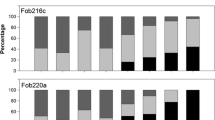Abstract
Onion breeding lines known to be resistant to Pyrenochaeta terrestris showed, in several locations, root-pruning symptoms that have been usually associated with only the action of P. terrestris. Fusarium oxysporum f. sp. cepae was invariably isolated from affected roots and the stem-plate area of these pink-root-resistant lines. Symptoms not commonly associated with the action of Fusarium, including darkening of dry scales of yellow bulbs and a reddening of scales of white bulbs, were noted. Controlled tests were conducted to establish (a) the pathogenicity of four isolates of F. oxysporum f. sp. cepae, (b) the reaction of onion breeding lines to inoculation at various temperatures with both the pink root and the Fusarium bulb rot organism, and (c) the pathogenic interaction of F. oxysporum f. sp. cepae with P. terrestris. The Fusarium isolates were pathogenic over a wide range of temperatures (20 to 38°C.). Host reaction to the organisms in combination depended on the level of susceptibility that was the greater to one or the other organism. Resistance to one did not markedly modify susceptibility to the other when both were present. Resistance to F. oxysporum f. sp. cepae was found in several onion lines.
Similar content being viewed by others
References
Aganostopoulus, P. T., Some diseases of fruit trees, vegetables and flowers caused by Fusarium sp. in Greece. 1932, 23 pp. Athens, A. B. Pasco. (Greek, with English summary).
Ann. report of the Department of Agriculture, Tanganyika, 1957 (Part II). 1958, 85 pp.
Blattny, C., Contribution to the study of fusariosis of onion (Allium cepa). Ochrana Rostlin 10 (1930): 149–153.
Botany and Plant Pathology Section. Ann. report Iowa Agr. Expt. Sta. for the year ending June 30, 1933. 1933, pp. 44–58.
Botany and Plant Pathology Section. Ann. report Iowa Agr. Expt. Sta., 1935–1936. 1936, pp. 97–113.
Davis, G. N., and Henderson, W. J., The interrelation of the pathogenicity of a Phoma and a Fusarium on onions. Phytopathology 27 (1937): 763–772.
DuPlessis, S. J., Pink root and bulb-rot of onions. Farming in South Africa 9 (1934): 70.
Feekes, F. H., Onderzoekingen over schimmelziekten van bolgewassen (Investigations on fungous tests of bulbs). Thesis, Univ. of Utrecht. 1931, 93 pp. Baarn, Hollandia-Drukkerij, 1931. (English summary).
Geard, J. D., Diseases of onions. Tasm. J. Agr. 30 (1959): 165–169.
Gorenz, A. M., Larson, R. H., and Walker, J. C., Factors affecting pathogenicity of pink root fungus of onions. Jour. Agr. Res. 78 (1949): 1–18.
Güssow, H. R., Progress report of the Dominion Botanist for the years 1931 to 1934, inclusive. Canada Dept. Agr. Div. Bot. 1935, 86 pp.
Kreutzer, W. A., Host-parasite relationships in pink root of allium cepa L. I. The pigment of Phoma terrestris. Phytopathology 29 (1939): 629–632.
Link, G. K. K., and Bailey, Alice A., Fusaria causing bulb rot of onions. Jour. Agr. Res. 33 (1926): 929–952.
McKay, R., Some unusual parasitic and non-parasitic diseases of plants observed in Ireland in 1953. J. Dept. Agr. Eire 50 (1953–54): 151–155.
Palo, M. A., A Fusarium causing bulb rot of onion in the Philippines. Philipp. Agr. 17 (1928): 301–316.
Plant diseases and insect pests. Notes by the Biological Branch. J. Dept. Agr. Vict. 41 (1943): 213–217.
Report on agricultural research for the year ending June 30, 1947. Report Iowa Agr. Exp. Sta., 1946–1947. 1947, pp. 158–159.
Pugsley, A. T., Root rot of onions. Jour. Dept. Agr. Vict. 36 (1938): 320.
Report Colo. Agr. Exp. Sta., 1952–1953. 1954, pp. 22–23.
Snyder, W. C., and Hansen, H. N., The species concept in Fusarium. Amer. Jour. Bot. 27 (1940): 64–67.
Thomas, W. D., Estimated losses in yields due to diseases of major crops in Colorado for 1952. Plant Dis. Reptr. 37 (1953): 118–120.
Woolliams, G. E., Fusarium bulb-rot of onions at Summerland, B. C. Report of Dominion Botanist for the year 1927, Div. of Botany, Canada Dept. Agr. 1928, pp. 189–192.
Additional information
Horticulturist, Pathologist, and Horticulturist, respectively, United States Department of Agriculture, Beltsville, Maryland, U.S.A.
Rights and permissions
About this article
Cite this article
Kehr, A.E., O'Brien, M.J. & Davis, E.W. Pathogenicity of Fusarium oxysporum f. sp. Cepae and its interaction with Pyrenochaeta terrestris on onion. Euphytica 11, 197–208 (1962). https://doi.org/10.1007/BF00033792
Received:
Issue Date:
DOI: https://doi.org/10.1007/BF00033792




